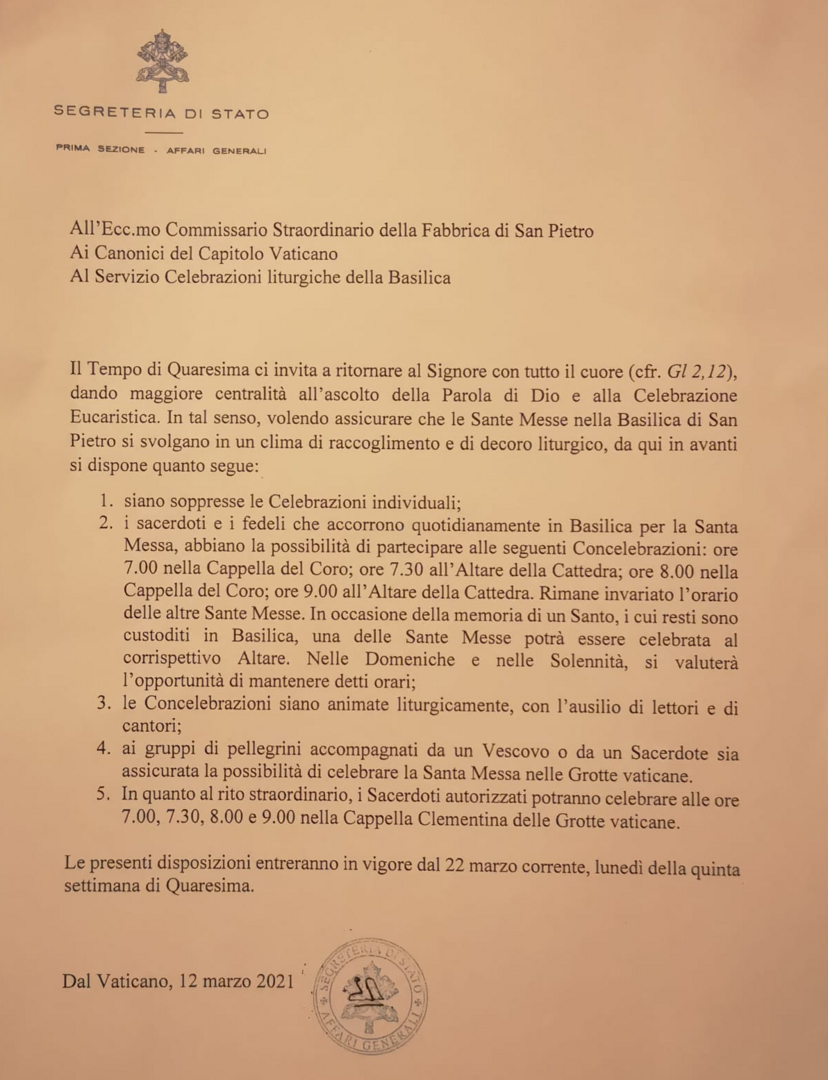The Vatican’s Secretariat of State has issued an instruction regarding the celebration of Mass in St. Peter’s Basilica, suppressing Masses said by a priest by himself, and restricting the celebration of the extraordinary form of Mass in the Latin rite to one altar in the crypt of the basilica.
The instruction comes from the First Section of the Secretariat of State, which deals with the general affairs of the church and is headed by Venezuelan-born Archbishop Peña Parra. He is the third-highest ranking official in the Roman Curia and is known as the “substitute” (or chief of staff).
The instruction, dated March 12, is addressed to three separate bodies. The first is the “extraordinary commissioner of the Fabric of St Peter’s,” meaning the person the pope has appointed to oversee the administration and upkeep of the basilica. Last June, the pope appointed Archbishop Mario Giordana as extraordinary commissioner; his role is to bring clarity to the administration of the Fabric and update its statutes.The second is the “canons of the Vatican Chapter” and the third is the “service for the liturgical celebrations of the basilica.”
The new Vatican instruction strictly limits the celebration of the extraordinary form of the Latin rite in the basilica, making clear that its usage is not intended to be the norm.
The Lenten season “invites us to return to the Lord with all our heart by giving greater centrality to listening to the Word of God and to the Eucharistic celebration,” reads the beginning of the instruction. “In this sense, wishing to ensure that the holy Masses in the Basilica of St. Peter’s are conducted in a climate of recollection and liturgical decorum, from now henceforth the following has been laid down.”

The instruction makes five specific points without explanation for them, but their aim appears clear: to ensure that there is order in the celebration of the Mass in St Peter’s basilica, and that Masses are celebrated in accordance with the norms and spirit of the liturgical renewal of the Second Vatican Council. It strictly limits the celebration of the extraordinary form of the Latin rite in the basilica, making clear that its usage is not intended to be the norm.
An informed source told America that every morning, priests (many of them working in the Roman Curia) celebrate Mass at side altars of the basilica, frequently by themselves and often in the extraordinary form. The aim of the instruction’s first point is to end this practice of “lone” celebrations.
Every morning, priests (many of them working in the Roman Curia) celebrate Mass at side altars of the basilica, frequently by themselves and often in the extraordinary form.
The second point of the instruction stipulates that “the priests and the faithful who go daily to the basilica for holy Mass should have the possibility to participate in the following celebrations,” listing the time and place of various Masses: at 7.00 a.m. at the Chapel of the Choir; at 7.30 a.m. at the Altar of the Chair; at 8.00 a.m. at the Chapel of the Choir; and at 9.00 a.m. at the Altar of the Chair. The times of other Masses remain unchanged. It says that “on the occasion of the memory of a saint, whose remains are kept in the basilica, one of the holy Masses can be celebrated at the corresponding altar.” It adds, however, that “on Sundays and on solemnities, the opportunity of celebrating Masses at these times will be evaluated.” This last point presumably refers to the fact that the pope will often celebrate in the basilica on Sundays or solemnities.
The focus on larger, shared liturgies rather than many lone Masses every day is in accord with the spirit of the liturgical renewal introduced by the Second Vatican Council. The aim of this instruction is to ensure that the liturgy is celebrated in accordance with the liturgical reforms of Vatican II and becomes abundantly clear in the third point of the instruction, which states that “the celebrations (of Masses in the basilica) should be liturgically animated, with the assistance of lectors and cantors.”
The fourth point of the instruction states that “groups of pilgrims, accompanied by a bishop or priests (should) be assured of the possibility of celebrating holy Mass in the Vatican grottoes,” meaning in the chapels of the crypt of the basilica or around the tomb of St. Peter.
The instruction’s fifth point permits the celebration of the extraordinary form of the Latin rite of the Mass (essentially the pre-Vatican II Mass) at four specific times (7 a.m., 7:30 a.m., 8 a.m. and 9 a.m. in the Clementine chapel of the Vatican grottoes.
The instruction concludes by stating that “the present dispositions will enter into force on March 22, Monday of the fifth week of Lent.”
More from America:
- Dear Pope Francis: Thank you for 8 years of challenging and healing the church. But women still deserve more.
- ‘It is not a sin to get a vaccine’: This Catholic bishop delivers clear and concise Covid messaging.
- People think they know how young people feel about religion. This group actually asks them








